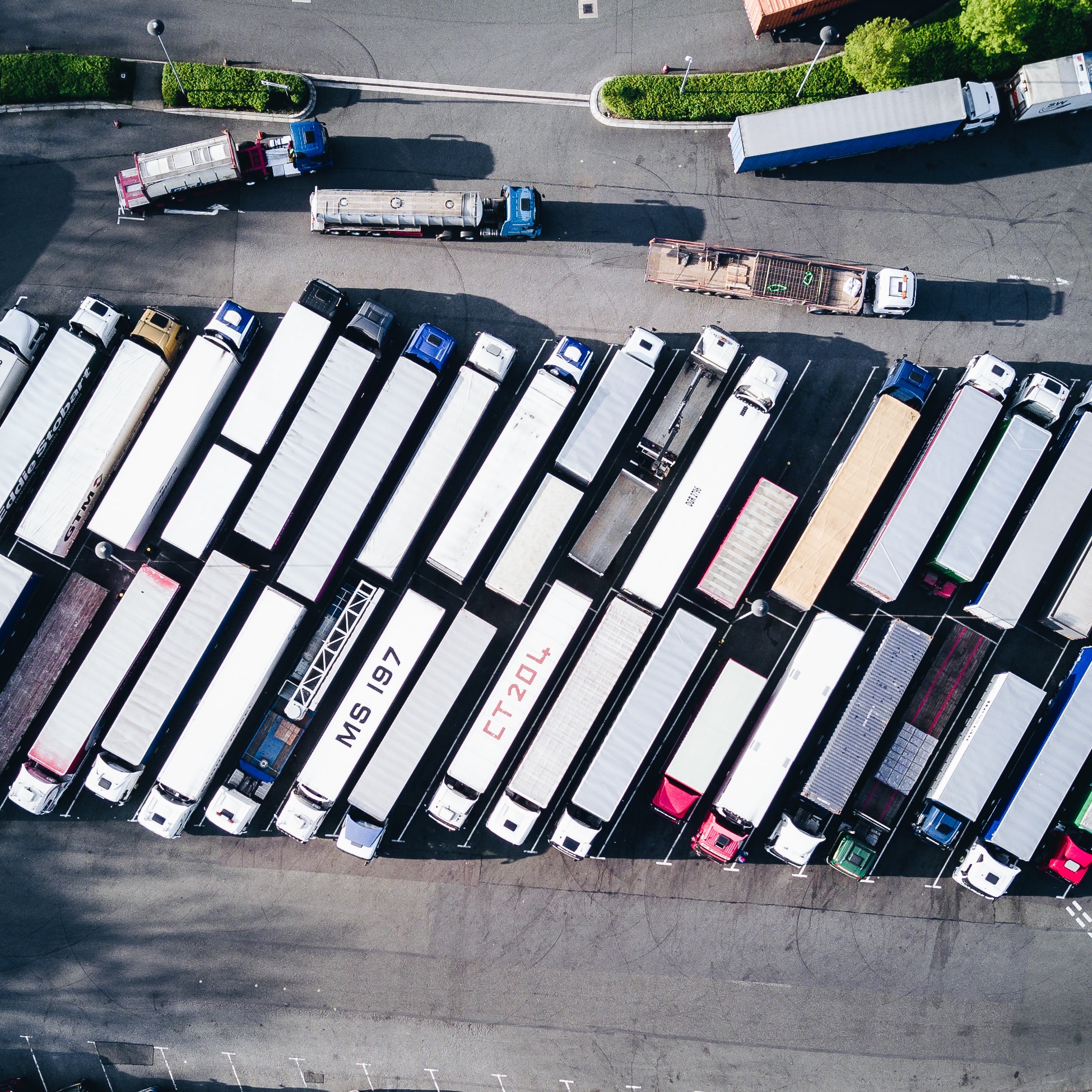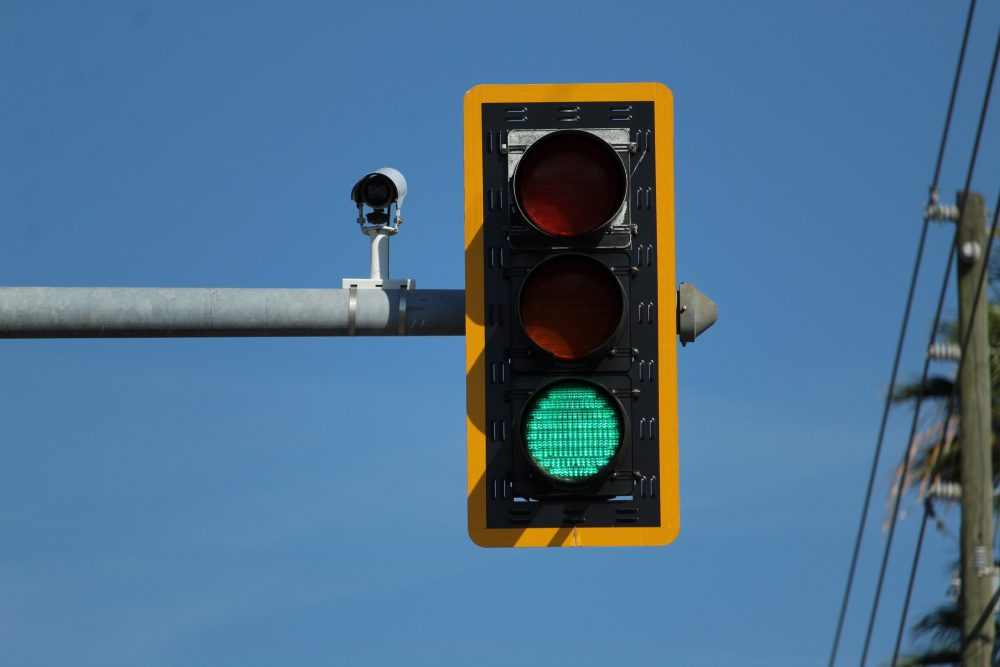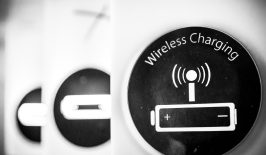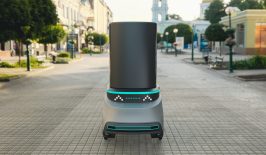Mobility 2045
You step out of the house and hear people laughing and birds chirping. From there, you walk across a green space. You’re intersected by a bike path, with many people gliding along on two wheels. At the next corner, you get on the bus that is just arriving. Although there are many people on the road at this time of day, you find a seat because there are enough buses. The e-bus quietly drives through the streets and drops you off in front of your office. On the way home, you get off in front of the supermarket and do your shopping. Since your bags are heavy, you rent one of the cargo bikes via an app. While you cycle home on the wide bike path, small electric vehicles transporting goods pass you on a narrow lane.
This – or something like it – is what mobility could look like in the climate-neutral city of the future, where combustion engines and private cars have become largely superfluous thanks to optimised public transport, a convenient cycling infrastructure, electrified sharing fleets and intelligent logistics. In rural areas, too, cars could be made dispensable in many places, with seamless and comfortable local transport available in the form of buses, trains, on-demand vehicles and autonomous minibuses.
We explore how this vision can become a reality and which role digital technologies play in the process.
Currently, transport is responsible for massive CO2 emissions
Let’s rewind to the present. Each new report by the Intergovernmental Panel on Climate Change (IPCC) calls for effective climate protection measures with increasing urgency, as we already live in a +1.2-degree world. Any further delay will lead to an additional rise in temperature. However, a look at different sectors clearly shows that, besides industry, transport is proving particularly resistant to reducing its CO2 emissions.
The transport sector, still mainly driven by fossil fuels, is one of the largest emitters of CO2 in Germany and contributes to around 20 percent of emissions. In 2019 alone, cars and the like were responsible for over 160 million tonnes of greenhouse gases. This is mainly attributable to emission-intensive transport means like cars and trucks, which cause almost all CO2 emissions related to road traffic.
This means we pay a high price to get from A to B and transport our goods. Not only are we fuelling the climate catastrophe, but we are also tolerating air pollution, noise, and high land consumption for parking spaces, roads and motorways. This determined by the German Advisory Council on the Environment (SRU) in its first report exactly 50 years ago.
Setting the framework for climate-neutral mobility
According to the Climate Protection Act, greenhouse gas emissions from transport in Germany must fall to 85 million tonnes of CO2 by 2030. This means almost halving emissions in the next seven years. The European Parliament even calls for a 60 percent reduction by 2030 and the Federal Environment Agency recommends that CO2 emissions in Germany be reduced by at least 70 percent by 2030. Furthermore, the emissions must continue to be reduced from there, falling to zero by 2045, so that Germany becomes greenhouse gas neutral – as stipulated in the Climate Protection Act.
According to the 2022 Climate Protection Report, however, it is foreseeable that the targets of the Climate Protection Act will be missed by a large margin in the transport sector – unless something changes quickly.
First and foremost, this includes avoiding traffic by shifting to climate-friendly means of transport such as rail, public transport and cycling. Secondly, traffic must be handled in a more climate-friendly and efficient way such as low-CO2 electromobility and intelligent transport systems. Third, strong local infrastructure that allows for short-distance travel should be prioritised.
For the mobility transition to gain momentum, consistent political action and a social rethink are needed, as mobility expert and activist Katja Diehl emphasises in an interview with RESET.
In the implementation of the various measures, as in many other areas, digitalisation is playing an increasingly important role.
Digital solutions for sustainable transport and logistics
When it comes to shifting traffic to rail, public transport and cycling, promoting low-CO2 transmission, managing the transport system more intelligently, and enabling short-distance urban transit, digital innovations are playing an increasingly important role in the transport sector.
Optimising public transport with data
One approach for a more attractive, sustainable public transport system is to combine the comfort of individual transport with the advantages of local public transport. On the one hand, this includes planning based on actual demand. If there is a lot of traffic, larger vehicles will run at closer intervals; if there is little traffic, smaller vehicles will be sent out at adapted intervals. On the other hand, passengers must be provided with information that is important for their journey and easily accessible. Will the bus be on time? Are there enough seats in the next vehicle, and will the bicycle still fit?
The prerequisite for this is that the important data for this information is collected and made available. With the help of artificial intelligence (AI), among other things, it is already possible to create accurate forecasts of occupancy in public transport.
Within the framework of NV-ProVI, a project between Stadtwerke Gießen and the data analysts at Brodtmann Consulting, for example, an AI-based algorithm was developed to generate forecasts for public transport in real-time using GPS data from buses and trains, timetables, route networks, historical data, weather data, and information about holidays and major events.
In addition to various traffic and real-time data, movement data will also be of interest for optimised planning and forecasting. However, as these can reveal a lot about people, they should be handled very carefully.
Expanding rural mobility with on-demand shuttles
In rural areas, life without a car is hardly possible today. The way to work, to the doctor, or simply to shops cannot be done in 10 minutes by bike, and many remote areas are inadequately or not at all connected to public transport. For the approximately 30 million people who live in rural regions in Germany and whose share of total passenger transport is about 37 percent, switching to public transport is challenging.
On-demand shuttle services are now being tested in many places to bridge the divide between shared public transport and individual car journeys. One of the largest projects in Europe is On-Demand Mobility for the Frankfurt/Rhine-Main region, which aims to reduce CO2 emissions in transport by filling gaps in public transport services with zero-emission vehicles. Route- and timetable-independent transport is organised through a digital platform. Passengers can book the appropriate route via an app, and the software behind it takes care of ridepooling, which combines the requests of different passengers for similar routes.
Autonomous vehicles can close gaps
Autonomous vehicles have potential in local public transport as small, driverless shuttle buses could help to massively expand local networks.
Various pilot projects are already testing the possibilities. In Darmstadt and in the district of Offenbach, a pilot operation will start in May 2023. Deutsche Bahn, the Rhein-Main-Verkehrsverbund (RMV), and local transport companies will send automated shuttles on the road, which, equipped with camera and sensor technology, will direct on-demand operations.
Automated vehicles hold great promise for driving more efficiently and saving energy compared to traditional cars. However, the energy consumption associated with automation and vehicle networking has been largely overlooked (as noted in SustAIn Magazine). According to a study by Agora Verkehrswende, the potential of automation can only be realized if these vehicles are used collectively and integrated into public transport, replacing passenger cars. To minimise additional energy consumption, efficient components should be selected and big data analysis processes employed to keep data transmission to a minimum.
Reducing CO2 emissions with ridesharing
Carpooling is another way to fill gaps in public transport and reduce CO2 emissions from individual car journeys. In any case, there is not enough space for additional passengers in most cars: in the EU, the average car carries less than two people. But with each additional passenger, the journey becomes more CO2-efficient. Regular carpooling in particular can therefore significantly reduce the negative impact of the mobility sector on our environment and, in the long run, even make owning a car obsolete.
New car-sharing platforms, such as PENDLA, are emerging as a solution. This crowd-based carpooling platform is designed for districts, cities and municipalities to facilitate the formation of regular carpools. Drivers can add their routes to the platform, which automatically compares them with those of other users to find the best match. The app then displays the matched routes on a map. PENDLA is specifically tailored for regular rides, allowing riders to choose the days of the week they drive the route and enabling other users to join these rides on a regular basis.
Smart roads optimise traffic flow
Simulations have long been crucial in managing traffic flows in cities. They inform when traffic lights should turn green and guide the placement of important traffic signs and overall road organisation. Furthermore, simulations can aid in reducing CO2 emissions.
The German project with the somewhat unwieldy name KI4LSA, for example, is developing AI for optimising traffic flow. The technology is designed to help passengers get from A to B faster, reduce road noise and, most importantly, reduce air pollution. The technology is designed to autonomously learn strategies to optimise traffic flow in real time and improve over time. The data collected is then made available as open data, which means that theoretically the whole world could use this technology.
Applications like these have the potential to decrease transport emissions. However, it is yet to be determined whether they will only make driving more convenient, which could lead to increased demand, or if they will truly reduce CO2 emissions in significant amounts.
Apps to boost bicycle mobility
Bicycles and e-bikes are the most environmentally-friendly mode of transportation when it comes to CO2 emissions and noise. The increased usage of two-wheelers directly improves air quality in cities, reduces traffic congestion, and frees up space previously reserved for cars, enabling other activities. Digital solutions like bike-sharing and rental systems, navigation, and route-planning apps make cycling more convenient and accessible.
For instance, Bike Citizens strives to integrate bike-friendly route planning with better infrastructure for two-wheelers. The navigation app displays cycle-friendly routes, and the data voluntarily recorded by users helps to better comprehend cycling. The objective is to equip cities and municipalities with the necessary knowledge to optimise cycling.
Hamburg’s PrioBike has a different approach: its app aims to create a green wave for cyclists. “In a sense, the app generates a ‘pseudo green wave’: if cyclists adjust their speed based on the app’s recommendations, they can enjoy a type of green wave within certain limits,” says Sven Fröhlich, who leads the project at TU Dresden. The app’s speed recommendations are based on a forecast that combines data from traffic light circuits, information about the current traffic situation, and the position and speed of the cyclists.
Digital solutions make e-mobility accessible
Achieving climate-neutral mobility requires embracing electromobility, but adoption of electric vehicles has been slow in many countries. Apart from the lack of political incentives, doubts about the range and availability of charging options have contributed to this. New digital solutions aim to address these issues by mapping charging stations and making it easier to plan routes for electric vehicles.
The importance of power source and battery longevity in e-mobility life-cycle assessment
Getting from A to B with an e-mobile is currently considered the most environmentally friendly way of getting around. But how do things really stand? We took a closer look at the life-cycle assessment of electrically powered vehicles. Read more here.
The apps Plugsurfing and PlugShare, for example, not only show free charging stations that are suitable for one’s vehicle, but also provide information on how reliable and convenient a station is. Likewise, concepts like Monta’s lay the foundation for a scalable and sustainable charging infrastructure. The open-source app and platform is a B2B software solution for companies that want to offer charging options for e-mobility on their business premises.
Sustainable logistics through digitalisation
Bicycle couriers have become the norm for pizza delivery in most major German cities, with many food and parcel delivery services also turning to cargo bikes or small, electric pedal-powered vehicles to deliver packages. These modes of transport are ideal for navigating narrow streets and busy city centres, saving time and resources by avoiding traffic jams and the search for parking spaces. Compared to cars, cargo bikes produce only one-tenth of the emissions, making them a sustainable and efficient option, particularly for last-mile logistics.
To support cargo bike delivery in urban areas, the SmartRadL project is developing an innovative software solution. The route planning software is specifically designed for delivery bike transport and continuously connects riders to the delivery management system. With real-time updates, the route plan can be quickly adjusted to accommodate new shipments.
But what about long-distance transport? In Germany, this is mainly carried out by road. Of course, the first priority should be to shift goods transport from road to rail and to switch to e-trucks. Compared to a truck, a goods train requires only about 20 percent of the energy per tonne-kilometre and produces only about 25 percent of its climate-damaging emissions, according to Agora Verkehrswende.
Digital solutions have the potential to increase the efficiency of rail transport by leveraging automation and data analysis to optimize capacity utilization and integrating freight transport with passenger transport. The CargoSurfer project aims to develop and implement a platform for brokering freight capacities, which will also include an AI-based forecasting tool to ensure the timely delivery of goods by optimizing transport connections.
If the so-called “freight on transit” concept works, existing infrastructure would be much better utilised and even remote places in rural areas could be integrated into the already existing public transport network.

AI to help trucks roll along our roads with lower emissions
It’s important to keep in mind that even with the rise of new e-truck registrations, there will still be many vehicles on the road powered by combustion engines in 2030. To decrease emissions by predicting and optimizing fuel consumption for each trip, the “FvfT” project has developed an AI-based application.
Mobility-as-a-Service megatrend: Using smartphones from A to B
Simply enter your starting point and destination into your phone, and the app will provide you with the best route based on your preferences – whether that be the quickest, most comfortable or most environmentally friendly option. The route may include walking, cycling, public transport, or even an on-demand shuttle depending on what is available. Real-time traffic information will also be displayed on the screen. The goal is to move from A to B using a variety of transportation options rather than relying solely on owning a personal vehicle. This concept is called Mobility-as-a-Service.
Mobility-as-a-Service works by using traffic and real-time data like GPS data from buses and trains, timetables, route networks and traffic reports. These data sources are linked together using digital tools and platforms. This creates an optimised and situational mobility experience where public transport is still a primary mode of transportation, but also integrates other regional services.
When different mobility services work in sync, users can experience seamless movement without worrying about traffic jams or parking. This integration can also lead to a reduction in transport-related CO2 emissions, less noise and air pollution, and more public space for everyone.
stadtnavi is a great example of how multiple sustainable transport options can be connected seamlessly to help people reach their destinations. It links various modes of transportation available in the Herrenberg region, enabling residents to plan and execute multimodal journeys with ease. Jana Zieger, who is in charge of the project, highlights that combining several eco-friendly transport options can save significant travel time. Apart from route planning, stadtnavi also provides location-specific details like the nearest bike station, ride-sharing options, availability of rental bikes, and cargo bikes.
stadtnavi Herrenberg – An invitation to copy & paste
Google Maps and other private-sector platforms are already used by many people as a mobility solution. What makes stadtnavi special is its open-source approach: “We wanted free licences, no advertising, and we didn’t want to give away the users’ data. We also wanted a solution that other municipalities and regions could use at low cost and that would not create a permanent dependency on one provider,” reports Jana Zieger from stadtnavi. In addition, the great added value of regional platforms is that the operators have much more individual design and development options. They can, for example, set priorities in climate and environmental protection and involve the population in further development.
Furthermore, creating and running a mobility app can serve as a tool for local authorities to handle the intricacy of their own mobility data. This includes analyzing the quality and availability of existing data, generating missing data, and utilizing newly acquired data to support eco-friendly transportation solutions.
There are already several municipalities and regions that have adopted their own mobility platforms inspired by stadtnavi Herrenberg. Additionally, many major cities have their own public transport companies that offer mobility apps like Jelbi in Berlin or Switchh in Hamburg. However, there are many other models as well, and the field is constantly evolving with many more platforms being developed and planned. According to Zieger, it’s a very dynamic field with a lot of movement.

In the 15-minute city, everything is around the corner
In the past decades, cities and other settlement structures have been designed with individual transport in mind – and have fuelled an increase in car traffic. Supermarkets on the entrance and exit roads, equipped with large car parks, are emblematic of this type of urban development. The 15-minute city, on the other hand, is an approach to rethinking the city of short distances. The idea behind it is that by having all important services around the corner, car traffic should decrease.
Digital solutions can support the planning and implementation of the 15-minute city. Read more here.
Challenges of digital mobility
Digitalization is important for the mobility transition, but it raises questions about data protection and sustainability. The hardware and software required for digital mobility solutions consume resources and energy. Therefore, it’s important to ensure that digitalization is pursued in a sustainable and responsible manner.
Protecting sensitive data
As the transportation system becomes increasingly automated and interconnected, it becomes more important to address questions related to data ownership, processing, and protection. Transparent and responsible data management is crucial to ensure the trust and acceptance of users. At the same time, easy access to data can foster innovation and the development of new mobility services.
To ensure trust and acceptance of users, it is crucial to have transparency in the processing of personal data for both manufacturers and operators. This can be achieved by providing easily understandable information to users about the data collected and its intended use, and allowing users to decide which data they release. Privacy by default, which includes data protection-oriented default settings, can make this possible. By implementing such measures, the goal of fostering innovation and new mobility services can be achieved while ensuring data privacy and protection.
Anonymisation or pseudonymisation procedures can be used to process data in a way that allows larger data sets to be collected without violating data protection laws’ principle of data economy. This approach is also recommended by Agora Verkehrswende for big data applications.
The freemove project, funded by the Federal Ministry of Education and Research (BMBF), is looking at possible technical solutions for anonymising movement data, such as differential privacy. With this procedure, information can be published while maintaining privacy without encrypting it. For this purpose, the data is provided with “noise” so that no clear statements can be made about certain properties of the data.
Open Source and Open Data promote innovation
Having a good data basis is crucial for new digital solutions, but data availability and quality in Germany can still be a challenge, especially for small municipalities and projects. While the Mobilithek of the Federal Ministry of Digital Affairs and Transport (BMDV) makes some traffic data openly available, it can be costly to ensure good and machine-readable quality. Additionally, open and free access to data for everyone is still not a common practice.
An open data law has been proposed by Agora Verkehrswende to improve data availability and quality for digital solutions in transportation. Such a law would establish regulations for disclosing data in standardized formats and ensuring its availability through an online portal.
Furthermore, municipalities and cities can benefit from the progress made by others if mobility apps and other applications are made available as open source without license fees and can be replicated and improved upon. Despite the success of stadtnavi Herrenberg and similar projects, open source applications remain uncommon in the transportation sector.
Keeping an eye on the eco-balance of digitalisation
Reducing the environmental footprint of digital tools and services is crucial, and can be achieved through various means such as using efficient devices and algorithms, and sourcing renewable energies for development and operation. Policymakers play a critical role in setting the appropriate framework conditions and promoting the development of sustainable devices, as well as improving recycling processes.
At the same time, it is important to digitalise moderately (“as much as necessary, as little as possible”) and to weigh the actual impact against the use of resources. The example of autonomous driving shows what is at stake: as already mentioned, autonomous minibuses are seen as a possible solution to promote environmentally friendly mobility in rural areas. However, autonomous driving only works through the use of many sensors and algorithms. In order to be able to assess the actual impact, it is therefore necessary to realistically evaluate how environmentally friendly the AI integrated in them and the resource consumption of the vehicles really are, as Andreas Meyer, research associate at the Distributed Artificial Intelligence Laboratory of the TU Berlin, states. To this end, the question must also be answered to what extent emissions are actually reduced by the new service because car journeys are eliminated or whether the resource consumption of the minibuses actually causes even more emissions.
Answers to many of these questions have yet to be found, as the resource consumption of digital applications is still not consistently included in impact analyses.
Conclusion: How to achieve a successful mobility transition
If the mobility transition, which is so urgent for effective climate protection, is to succeed, the essential measures must be implemented quickly. Digitalisation in particular can play an important role in this:
The Mobility-as-a-Service (MaaS) approach makes our smartphone the most important tool and navigator for diverse alternative mobility options. With apps that link public transport with cycling and ridesharing services, we can quickly find the fastest routes in real time. Our digital footprint also provides valuable data for creating and developing new mobility services, as well as for effective transport research and planning. In logistics, the digital networking of all road and rail-based modes of transport in a communicative system will lead to new solutions for reducing CO2 emissions. This will not only enable the seamless management of complex transport chains across different modes of transport but also promote more efficient use of existing structures.
Despite the availability and growing use of various mobility solutions, such as the ones mentioned earlier, the reduction of CO2 emissions in the transportation sector has been minimal in recent years. The number of internal combustion vehicles on our roads has not decreased, and the expansion of the rail network and public transport has not been substantial. Therefore, it is evident that the necessary transformation is not just a matter of knowledge but also a challenge of implementation.
Therefore, a strong policy is needed to create a framework for a successful mobility transition. This policy should include instruments to limit car traffic and reduce emissions, such as consistent parking space management, taxes and levies on combustion engines, CO2 charges, speed limits, and the expansion of rail and local public transport. In addition, specific funding programs and practical projects that promote new and innovative mobility solutions should be encouraged. Strengthening new alliances of actors that involve politics, administration, private sector, civil society, and science is also essential. Such cooperation can lead to the development of new, integrated solutions and achieve broad support and acceptance for the necessary changes.
At the same time, it is important to explore all possibilities for a rapid transformation and rethinking. As the example of stadtnavi shows, municipalities and cities can set an important course for the mobility transition on site by promoting intelligent solutions themselves. Companies can initiate the mobility transition by implementing sustainable concepts such as e-fleets, charging stations in car parks or ridesharing apps for their employees. Citizens have the opportunity to initiate sustainable digital mobility concepts in house communities and cooperatives, such as digitally supported cargo bike and car sharing.
Digitalisation is transforming the entire transportation sector, and we are only at the early stages of this transformation. The rapid advancement of automation, increasing networking, and the emergence of new collaborative mobility solutions will undoubtedly trigger further changes in mobility behaviour and the transportation system. However, given the challenges posed by digital transformation in transportation, it is clear that this process must be actively shaped by policy-makers to become the sustainable mobility of the future.


















